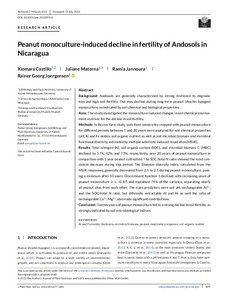| dcterms.abstract | Background: Andosols are generally characterized by strong resilience to degradation and high soil fertility. This may decline during long-term peanut (Arachis hypogea) monoculture, as indicated by soil chemical and biological properties. Aims: The study investigated the monoculture-induced changes in soil chemical environment as driver for the decline in soil fertility. Methods: In this on-farm study, soils from seven sites cropped with peanut monoculture for different periods between 1 and 20 years were analyzed for soil chemical properties (pH, Al and Fe oxides, soil organic matter) as well as soil microbial biomass and microbial functional diversity, estimated by multiple substrate-induced respiration (MSIR).
Results: Total nitrogen (N), soil organic carbon (SOC), and microbial biomass C (MBC) declined by 57%, 62%, and 73%, respectively, over 20 years of peanut monoculture in comparison with 1 year peanut cultivation. The SOC/total N ratio showed the most consistent decrease during this period. The Shannon diversity index, calculated from the MSIR responses, generally decreased from 2.5 to 2.1 during peanut monoculture, passing a minimum after 10 years. Discriminant function 1 declined with increasing years of peanut monoculture (r = –0.87) and explained 74% of the variance, separating nearly all peanut sites from each other. The main predictors were soil pH, exchangeable Al³+, and the SOC/total N ratio, but dithionite extractable Al and Fe as well the ratio of exchangeable Ca²+/Mg²+ also made significant contributions.
Conclusion: Twenty years of peanut monoculture led to a strong decline in soil fertility, as strongly indicated by soil microbiological indices. | eng |


